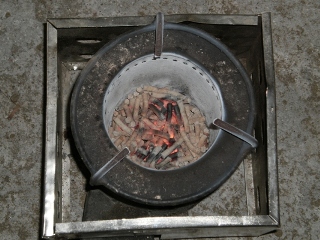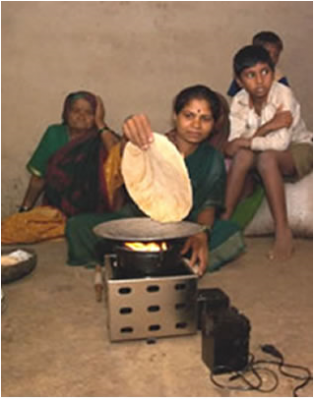Submitted by WOTR RE on
Background:
Cooking and lighting constitute around 75% of the total energy requirement in rural areas. Most of the cooking is done on traditional three stone wood stoves. These stoves are highly inefficient and the smoke emanating from them is very hazardous to the health of the rural population. According to the recent study made by the WHO, around 1.6 million people die every year in developing nations due to the problem of Indoor Air Pollution. The wood used for cooking is gathered form nearby shrubs or by felling trees. This practice, followed for decades, has resulted in a highly degraded environmental condition in our villages. Poor health and degraded environment are vital links in the vicious cycle of poverty in rural India. In order to improve the standard of living of the rural poor we have to urgently address their domestic energy needs.
In view of these issues, WOTR has developed in-house, a clean and efficient biomass cooking stove. This stove runs on pellets made of agricultural waste and is designed to give an output close to that of a LPG burner. The stove has been tested extensively in our villages and has been proven to be a sound solution to their cooking energy needs.
Agni biomass Stove:
Principles of operation
When burning any biomass, various combustible gases (smoke) must be driven from the solid fuel and then the burned. Combustion of biomass is cleaner when the air is well mixed with only combustible gases, instead of having the combustion occur in zones where solid fuel is still present. The creation and combustion of these gases separate from their solid fuel source is a clearly distinguishing characteristic of a gasifier. The Agni biomass stove works like a mini gasifier to combust the volatile matter of the fuel pellets cleanly and efficiently.
More specifically the principle of operation of the Agni biomass stove is that of a Top Lit Updraft Gasifier (TLUD). This simply means that the fuel is lit at the top of the heap (Top Lit) and the air for combustion moves in the upward direction hence ‘updraft’.
Figure 1 shows the principle of operation of the stove(view image gallery).
The updraft is produced by a fan or blower (3” computer fan) which is powered by a battery. Once lit the pellets are heated to produce combustible matter which is then ignited when it enters the secondary air zone. The burning continues to take place in this zone until all of the pellets are converted to ash or volatiles. Of crucial importance in the stove are the flows of primary and secondary air. In the gasifiers, the flows are separate but in most regular stoves, they are mixed. Control of air flow leads to clean combustion and higher flame temperatures.
TLUD gasifiers operate with batches of fuel, so they must be emptied and refilled once the flame runs out.
Fuel Pellets:
TLUD micro-gasifiers excel in the variety of fuels that they can use. The fuel requirements are dry biomass that is the size of chips or small chunks through which the upward primary air can pass, but not blow freely in channels. A wide variety of agricultural wastes (rice husks, sugarcane bagasse, wood dust etc) can be pelletized and used in the stove. Generally a combination of these along with a binder (e.g. molasses) is used in pellet production. The size of the pellets varies form six to twelve mm in diameter with a length of around 20 to 30 mm.
The pellets can be produced in bulk in a cattle feed plant (with slight modifications) which has an easy access to agricultural waste. From there it can be packaged and transported as and when required.
Specifications of Agni biomass stove
Figure 2 shows a woman cooking on the Agni biomass stove. (view image gallary)
Table 1 gives important details of the Agni Biomass Stove.
|
Specifications |
|
|---|---|
|
Average Input kW |
2.5kW |
|
Heat Transfer Efficiency |
50% |
|
Burning Time |
Up to 1.25 hrs |
|
Turn down ratio |
1:1.7 |
|
Batch Size (ф8mm pellets) |
725gms |
|
Weight |
5.2Kgs |
|
Dimensions(L*B*H) |
250*250*200mm |
Following are some salient features of the stove:
- The output of the stove resembles that of a standard LPG stove. The bluish flame burns without soot or smoke throughout the operation of the stove. Its intensity can be varied by varying the fan speed.
- A single batch of pellets can easily cook a meal for a family of up to six. The amount of pellets in the chamber can be varied according the requirements of the user.
- A starting material (e.g. kerosene) is required for easy start of the stove. Once started the stove must be run till all the pellets in the combustion chamber is burnt completely.
- The stove unit is mobile which simplifies the activity of cooking. Also, an outer box is provided to prevent any contact with the hot central chamber while the stove is running.
- Casting material is utilized for the combustion chamber to withstand the high temperatures of combustion.
- Log in to post comments



